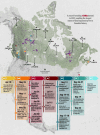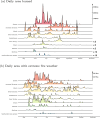Drivers and Impacts of the Record-Breaking 2023 Wildfire Season in Canada
- PMID: 39164286
- PMCID: PMC11335882
- DOI: 10.1038/s41467-024-51154-7
Drivers and Impacts of the Record-Breaking 2023 Wildfire Season in Canada
Abstract
The 2023 wildfire season in Canada was unprecedented in its scale and intensity, spanning from mid-April to late October and across much of the forested regions of Canada. Here, we summarize the main causes and impacts of this exceptional season. The record-breaking total area burned (~15 Mha) can be attributed to several environmental factors that converged early in the season: early snowmelt, multiannual drought conditions in western Canada, and the rapid transition to drought in eastern Canada. Anthropogenic climate change enabled sustained extreme fire weather conditions, as the mean May-October temperature over Canada in 2023 was 2.2 °C warmer than the 1991-2020 average. The impacts were profound with more than 200 communities evacuated, millions exposed to hazardous air quality from smoke, and unmatched demands on fire-fighting resources. The 2023 wildfire season in Canada not only set new records, but highlights the increasing challenges posed by wildfires in Canada.
© 2024. Crown.
Conflict of interest statement
The authors declare no competing interests.
Figures








References
-
- Skakun, R. et al. Extending the National Burned Area Composite Time Series of Wildfires in Canada. Remote Sens.14, 3050 (2022).10.3390/rs14133050 - DOI
-
- Wang, Z. et al. Severe Global Environmental Issues Caused by Canada’s Record-Breaking Wildfires in 2023. Adv. Atmos. Sci. 10.1007/s00376-023-3241-0 (2023).
-
- Bush, E. & Lemmen, D. S., editors. Canada’s Changing Climate Report; Government of Canada, Ottawa, ON. 444 p. (2019).
-
- Hanes, C. C. et al. Fire-regime changes in Canada over the last half century. Can. J. Res.49, 256–269 (2019).10.1139/cjfr-2018-0293 - DOI
-
- Flannigan, M. D., Logan, K. A., Amiro, B. D., Skinner, W. R. & Stocks, B. J. Future area burned in Canada. Climatic change72, 1–16 (2005).10.1007/s10584-005-5935-y - DOI
LinkOut - more resources
Full Text Sources
Miscellaneous

